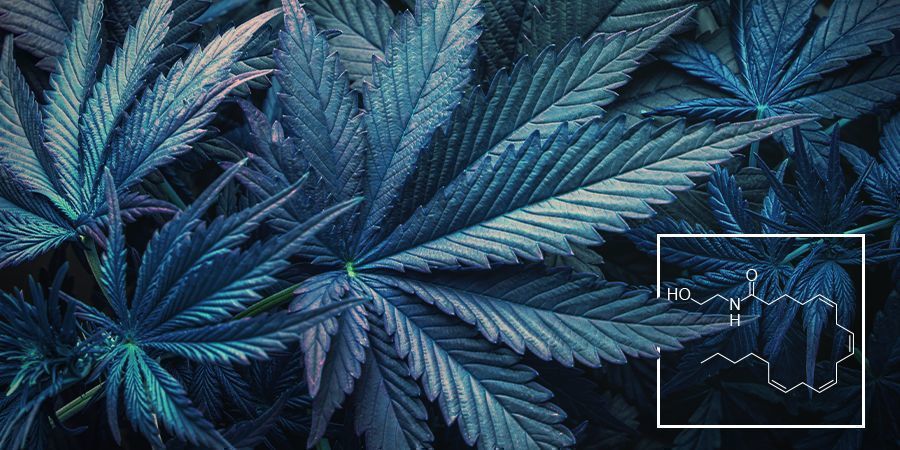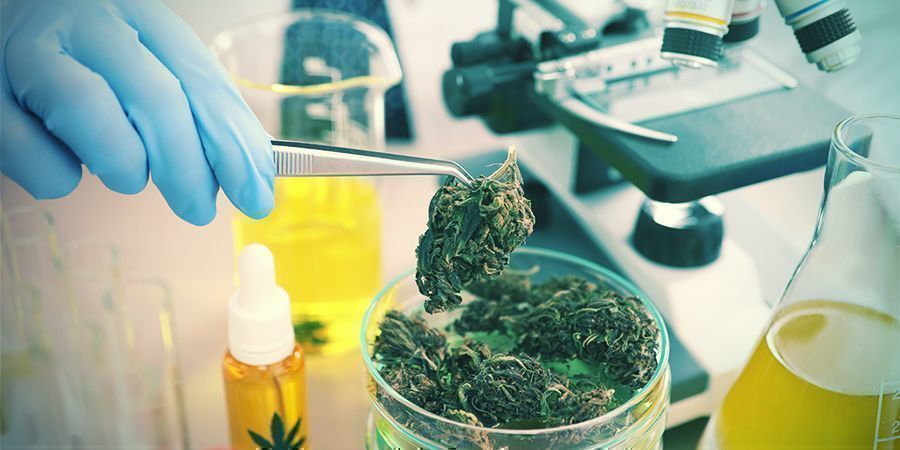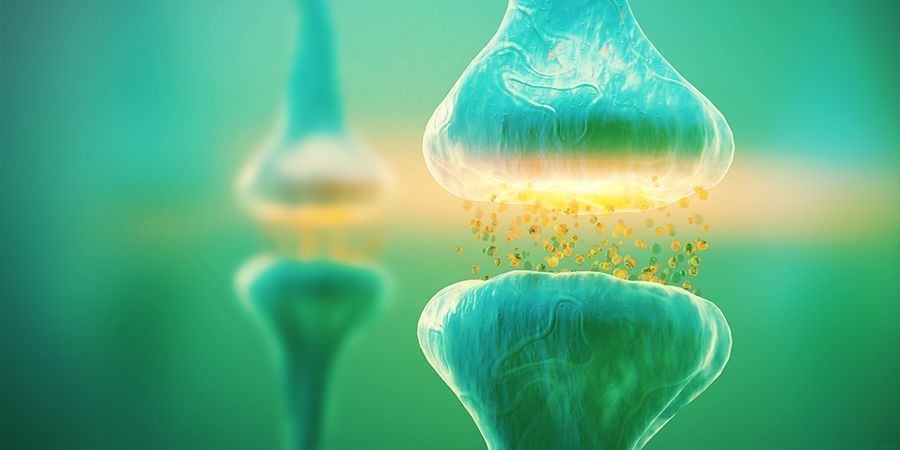
Anandamide: How Cannabis Makes You Happy
Anandamide, or AEA, is an endocannabinoid with a reputation for being a "bliss molecule". But, what exactly does this mean, and what is anandamide's relationship with cannabinoids like THC and CBD? Read on to uncover the mystery behind how cannabis makes you happy.
The cannabis plant has long enchanted scientists with a seemingly never-ending host of discoveries waiting to be unlocked—each more exciting than the last. But, perhaps most intriguingly, cannabis has helped us learn more about how our own bodies work. You see, in addition to plant-derived cannabinoids, there is another class of cannabinoids—those produced by the human body. So, what’s the secret behind anandamide, one of the two primary endocannabinoids holding the spotlight?
Below, we dig into the details on this "bliss molecule", including its action in the body, its relationship with THC and CBD, and just how cannabis is capable of making us feel happy.
What Is Anandamide?

Although THC, CBD, and other plant-derived cannabinoids—“phyto”-cannabinoids—are the ones we hear about most frequently, humans are another valuable source of these molecules. Endogenous cannabinoids—endocannabinoids—such as anandamide display unique actions of their own, and sustain significant interactions with plant-derived cannabinoids.
How Did Anandamide Get Its Name?
To begin any discussion on anandamide—aka AEA—it helps to explain the origin of its name. “Ananda”—sanskrit for “joy, bliss, and delight”—immediately hints at some of the key functions of this endogenous cannabinoid. “Amide” simply refers to the molecule’s chemical formula.
How Was Anandamide Discovered?
Interestingly, anandamide, and the other primary endocannabinoid 2-arachidonoylglycerol (2-AG), was discovered long after the discovery of phytocannabinoids like THC and CBD. In the early 1990s, upon determining phytocannabinoids were capable of binding with receptors in the human body, a research team led by Dr Raphael Mechoulam managed to isolate the first endocannabinoid in the human brain in 1992—anandamide.
How Does the Body Produce Anandamide?
Anandamide’s biosynthesis stems from the production of its membrane precursor N-arachidonoyl phosphatidylethanolamine (NAPE). This reaction takes place via numerous enzymes and molecular pathways, with neurons creating the substance as necessary. Natural levels of anandamide in the body are typically low, and the cannabinoid has a short half-life, meaning it leaves the body relatively quickly.
Why Is Anandamide Important?
So, if anandamide naturally exists in low concentrations in the body, why are researchers so interested in it? This is where we can begin to enter a discussion on the endocannabinoid system.
Composed mainly of two cannabinoid receptor types—CB1 and CB2—the endocannabinoid system plays a homeostatic role in which it oversees a wide variety of bodily processes. When Mechoulam’s team (made up of Lumír Hanuš and William Devane) discovered that phytocannabinoids were capable of binding to these receptors, they were determined to get to the bottom of this relationship. As a result, they discovered that anandamide has a very similar binding affinity for cannabinoid receptors as one of the most abundant cannabinoids found in cannabis—THC.
As partial agonists of CB1 and CB2, AEA and THC are both able to exert effects on the central nervous system and immune system, among others. Yet, despite the innate relationship between anandamide and CB1, THC’s relationship with the receptor is even stronger, catalysing much more significant chemical changes for a longer period of time. Anandamide is more fragile, and thus isn’t capable of causing a “high” like that of THC.
What Is Anandamide Responsible For?
As mentioned above, the word “anandamide” itself begins to describe one of its primary functions in the body. Indeed, the compound is found in areas of the brain linked to pleasure, reward, and motivation. However, it is also found in areas relevant to learning and memory, feeding, and movement. Researchers have even found preliminary evidence of anadamide’s ability to make or break short-term neural connections, potentially leading to benefits in learning and memory.
Generally, anandamide plays a homeostatic role. It is released by the brain as needed to help the endocannabinoid system run smoothly.
What Does the FAAH Enzyme Do?
Understanding the relationship between cannabis, anandamide, and the endocannabinoid system becomes clearer when we reveal how anandamide is processed. As mentioned, anandamide has a short half-life, and is quickly broken down into arachidonic acid and ethanolamine by an enzyme known as fatty acid amide hydrolase (FAAH).
As such, FAAH inhibitors are capable of elevating levels of anandamide in the body, which researchers are eager to exploit for potential therapeutic purposes. In fact, some people are born with a genetic mutation that significantly dampens natural levels of FAAH, leading to much higher concentrations of AEA in the body. The result? Potential improvements in mood, nociception, response to stressful events, and more.
While most people's natural levels of AEA are generally low, what if we were to boost the concentration? And, how would we go about doing so?
How Does Cannabis Affect Anandamide?

Cannabis has a multifaceted relationship with anandamide, as individual cannabinoids sustain dramatically different effects on the molecule. Let's examine how the two main cannabinoids—THC and CBD—impact AEA.
How Does THC Affect Anandamide?
THC and anandamide have a similar chemical structure, and both are partial agonists of the CB1 receptor; but when THC is consumed, it “hijacks” these receptors. Moreover, THC is capable of eliciting a much more dramatic response from CB1, manifesting in the characteristic “high” experienced by cannabis consumers.
More specifically, THC alters functioning of the hippocampus, orbitofrontal cortex, cerebellum, and basal ganglia, causing changes in short-term memory and coordination, among others. It also stimulates the release of dopamine—much more than is produced naturally—a brain chemical involved in pleasure, reward, feeding, sex, and more.
The Impact of Cannabis on Dopamine Levels
Produced in the brain, dopamine is a chemical released by neurons to send electrical signals to one another. These signals are essentially behind the choices we make in our daily lives. Simply put, dopamine plays a vital role in motivation, mood, attention span, and learning—all factors we encounter daily, whether consciously or subconsciously.
So, how does cannabis impact dopamine levels? Well, it's certainly no secret that, on its own, THC can produce effects that cause changes in motivation, mood, and focus. According to the research below, THC can interact with parts of the brain that produce dopamine in both the short and long term, with varied results.
In the short term, THC causes a considerable increase in dopamine, directly interacting with the reward system in our brain. This is an area responsible for feelings of relaxation, creativity, motivation, and euphoria. The brain works overtime in the presence of THC, increasing the amount of dopamine released. However, because of this, the effects don't last very long, as the brain will begin to temporarily “turn off” some dopamine receptors. This means that more THC is required to maintain the same effects over time.
While short-term use can directly increase dopamine release, more extended periods of use can possibly cause adverse changes to the dopaminergic system, effectively blunting the reward system through regular and extended THC use. Research has shown that intaking large, continuous amounts of THC can actually lower the amount of dopamine produced, potentially creating negative emotions and reduced motivation.
How Does CBD Affect Anandamide?
CBD, the other primary cannabinoid in cannabis, has a much more direct effect on anandamide than THC, despite having an indirect relationship with cannabinoid receptors in general. It all has to do with FAAH, which, as mentioned, is responsible for breaking down AEA—and the reason why anandamide doesn’t stay in the system very long.
Compellingly, CBD inhibits the breakdown of FAAH, causing anandamide to last longer in the synaptic cleft. This doesn’t cause a high like THC would, as anandamide’s binding affinity for CB1 doesn’t change, but it is able to exert its effects longer and with potentially more significant results.
Can Marijuana Make You Happy in the Long Term?

The question of whether marijuana can make you happy in the long term is one rife with variables. Given THC’s similarity to anandamide, as well as the potential soothing properties of other cannabinoids like CBD, it stands to reason that cannabis use can help you nurture a better, more open outlook on life. Though THC’s release of dopamine is believed to be partially behind this effect, its similarities to AEA are arguably more crucial regarding potential long-term improvements in mood.
A qualitative study on cannabis use in a Swiss male prison from 2009–10, published in 2013, alludes to this with its findings. Both the detainees and the staff reported positive effects associated with cannabis, including its ability to ease the prison experience, relieve tension, prevent violence, and act as a “social pacifier”. Access to marijuana was also believed to limit the use of harder drugs in the respondents. Negative effects of cannabis use included sleepiness, social isolation, and, under restriction, the use and trafficking of harder drugs.
Other anecdotal and preclinical studies suggest a potential spirit-lifting effect of cannabis that could help regulate mood in certain users. However, overuse of THC is believed to downregulate endocannabinoid activation—specifically, CB1 receptors in the central nervous system—making it more difficult to achieve the same feeling of pleasure over time at the same dose.
For this reason, it’s often recommended to enjoy strains with THC levels below 20%, and, if possible, with a good helping of CBD. This way, not only will you experience the benefits of THC, but you'll also raise natural levels of anandamide in the body thanks to CBD's inhibition of FAAH. Being “happy” is a lot more complicated than just a discussion surrounding anandamide and cannabis, but it ultimately leads to the conclusion that responsible weed use could help one look on the bright side.
Other Ways to Increase AEA in the Body

Aside from smoking or vaping THC-rich cannabis, augmenting anandamide levels in the body can be done with certain foods, activities, and even other cannabinoids. Some of these substances contain anandamide itself and/or inhibit FAAH, leading to naturally elevated AEA levels in the body.
1. CBD Extract
Yes, CBD extract, like that found in CBD oils, CBD capsules, and supplements, is one of the best ways to raise AEA levels in the body. As mentioned, this is down to CBD’s inhibition of FAAH, resulting in a slower breakdown of anandamide. In addition to this process, CBD engages with the endocannabinoid system in other ways, promoting overall homeostasis in the body.
It’s recommended to take CBD in extract form, as opposed to smoking or vaping, as dosing is made far easier, and it’s possible to consume larger amounts for a more significant impact.
2. Eat Certain Foods
Various foodstuffs contain a wealth of unique compounds that can also impact AEA levels in the body.
- Black Truffles
Black truffles are intriguing life forms independent of their effect on AEA, but here too they display something fascinating. Despite not containing any cannabinoid receptors themselves, winter black truffles contain AEA and many of the metabolic enzymes involved in the ECS. Researchers believe this could be in an effort for the truffles to attract hungry animals to spread their spores.
- Chocolate
In addition to containing caffeine, sugar, and theobromine, chocolate contains small amounts of anandamide alongside two compounds that inhibit its breakdown. This combination is thought to be partly responsible for the cravings associated with chocolate.
- Maca Root & Galangal
Maca root, or Peruvian ginseng, contains macamides, which are FAAH inhibitors with a similar chemical structure to anandamide. Maca root is commonly used as a supplement, with a range of traditional and modern uses.
Galangal, which is closely related to ginger and turmeric, is commonly used in East and Southeast Asian cooking, and has several traditional applications of its own. It too is a FAAH inhibitor capable of raising AEA levels.
- Kaempferol
Kaempferol is one of the most potent FAAH-inhibiting flavonoids. Found in common fruits and vegetables such as apples, blackberries, grapes, peaches, raspberries, broccoli, Brussels sprouts, cucumbers, endive, green beans, lettuce, potatoes, spinach, squash, tomatoes, and green tea, it’s possible to raise anandamide levels just by maintaining a healthy, diverse diet.
- Black Pepper and Long Pepper
Black pepper and long pepper both contain the alkaloid guineensine, which inhibits cellular reuptake of both AEA and 2-AG. The compound is also believed to offer potential soothing properties via cannabinoid receptors. Interestingly, black pepper also contains the dietary cannabinoid/terpene caryophyllene, which binds to the CB2 receptor, producing positive effects of its own.
3. Exercise

Exercise—specifically endurance exercise—has been shown to dramatically raise levels of anandamide in blood plasma. This mechanism is believed to be partially behind the “runner’s high” phenomenon, which long posited dopamine as the sole chemical responsible for the euphoria and analgesia often experienced following activity. So, if you want to release more anandamide, alongside other endorphins, long-distance running, biking, and other endurance activities are a great bet.
4. Increase Oxytocin Levels
Oxytocin, dubbed the “love hormone”, may stimulate the release of anandamide in the nucleus accumbens, as demonstrated by a 2015 animal study out of the University of California, Irvine. Oxytocin is naturally released by the pituitary gland during childbirth, intimacy (hugging, orgasm), social bonding, and in other instances. This means, activities like cuddling, or even yoga, may naturally increase levels of the sensual hormone.
Anandamide — The Bottom Line
Our knowledge of anandamide has come a long way since the endocannabinoid was first discovered, but there’s still a long way to go in learning how exactly we can use cannabis to help us feel happy in the long term. That said, by enjoying THC-rich cannabis in moderation, taking CBD oil, exercising, and enjoying a well-balanced diet, you can naturally boost your AEA levels!
- (n.d.). A biosynthetic pathway for anandamide | PNAS - https://www.pnas.org
- (n.d.). General Chemistry Online: The Bliss Molecule - https://antoine.frostburg.edu
- (n.d.). Microdeletion in a FAAH pseudogene identified in a patient with high anandamide concentrations and pain insensitivity - https://bjanaesthesia.org
- (2013/11/01). Cannabis use in a Swiss male prison: Qualitative study exploring detainees’ and staffs’ perspectives - ScienceDirect - https://www.sciencedirect.com
- (2015/02/01). Truffles contain endocannabinoid metabolic enzymes and anandamide - ScienceDirect - https://www.sciencedirect.com
- (n.d.). ‘Love hormone’ helps produce ‘bliss molecules’ to boost pleasure of social interactions | UCI News | UCI - https://news.uci.edu
- A Dietrich, & W F McDaniel. (2004/10/01). Endocannabinoids and exercise - https://bjsm.bmj.com
- Bloomfield, Michael A. P., Ashok, Abhishekh H., Volkow, Nora D., Howes, & Oliver D. (2016, November). Bloomfield MAP, Ashok AH, Volkow ND, Howes OD. The effects of Δ9-tetrahydrocannabinol on the dopamine system. Nature. 2016;539(7629):369-377. doi:10.1038/nature20153 - https://www.nature.com
- Chad A. Sallaberry, & Laurie Astern. (2018). The Endocannabinoid System, Our Universal Regulator - https://pdfs.semanticscholar.org
- di Tomaso, E, Beltramo, M, Piomelli, & D. (1996-08-01). Brain cannabinoids in chocolate. - https://escholarship.org
- Erik B. Oleson, & Joseph F. Cheer. (2012, August). Oleson EB, Cheer JF. A Brain on Cannabinoids: The Role of Dopamine Release in Reward Seeking. Cold Spring Harbor Perspectives in Medicine. 2012;2(8). doi:10.1101/cshperspect.a012229 - https://www.ncbi.nlm.nih.gov
- L Thors, M Belghiti, & C J Fowler. (2008/09/09). Inhibition of fatty acid amide hydrolase by kaempferol and related naturally occurring flavonoids - https://www.ncbi.nlm.nih.gov
- Reynoso-Moreno I, Najar-Guerrero I, Escareño N, Flores-Soto ME, Gertsch J, & Viveros-Paredes JM. (11/01/2017). An Endocannabinoid Uptake Inhibitor from Black Pepper Exerts Pronounced Anti-Inflammatory Effects in Mice - PubMed - https://pubmed.ncbi.nlm.nih.gov
- Smalheiser, & Neil R. (2019). Frontiers | A Neglected Link Between the Psychoactive Effects of Dietary Ingredients and Consciousness-Altering Drugs | Psychiatry - https://www.frontiersin.org
-
 3 min
30 April 2024
Why Does Cannabis Give You The Munchies?
Cannabis and the munchies go hand in hand, but what is it about our cherished herb that causes it? Well, scientists have done some digging and come up with some pretty comprehensive theories.
3 min
30 April 2024
Why Does Cannabis Give You The Munchies?
Cannabis and the munchies go hand in hand, but what is it about our cherished herb that causes it? Well, scientists have done some digging and come up with some pretty comprehensive theories.
-
 3 min
19 April 2024
Why Cannabis Makes You Laugh
Finding it hard not to giggle? Cannabis has the unmistakable ability to make even the most sour-faced person laugh, and it is all thanks to how it interacts with the brain.
3 min
19 April 2024
Why Cannabis Makes You Laugh
Finding it hard not to giggle? Cannabis has the unmistakable ability to make even the most sour-faced person laugh, and it is all thanks to how it interacts with the brain.
-
 4 min
22 December 2022
Why Cannabis Causes Red Eyes (And What To Do About It)
We're sure you've been there: your eyes are red after smoking, but you have to meet up with your boss or even your parents, and they can't know you're high. What can you do about it? Is it...
4 min
22 December 2022
Why Cannabis Causes Red Eyes (And What To Do About It)
We're sure you've been there: your eyes are red after smoking, but you have to meet up with your boss or even your parents, and they can't know you're high. What can you do about it? Is it...
-
 3 min
23 June 2022
6 Cannabis Strains To Make You Feel Talkative And Social
Some people find that weed helps them through a social setting. There are certain strains that can loosen your tongue and let the words flow. If you think cannabis can help you come out of your...
3 min
23 June 2022
6 Cannabis Strains To Make You Feel Talkative And Social
Some people find that weed helps them through a social setting. There are certain strains that can loosen your tongue and let the words flow. If you think cannabis can help you come out of your...
-
 5 min
13 October 2020
How To Prevent Cannabis Couch-Lock
Many of us have been there. After taking one too many hits or enjoying a particularly potent strain, you find yourself glued to your spot on the sofa. Experiencing a full-body high is extremely...
5 min
13 October 2020
How To Prevent Cannabis Couch-Lock
Many of us have been there. After taking one too many hits or enjoying a particularly potent strain, you find yourself glued to your spot on the sofa. Experiencing a full-body high is extremely...
-
 4 min
4 July 2018
Top 10 Cannabis Strains For Relaxing
We’ve got 10 marijuana varieties designed to de-stress and help you kick back and relax after a long, hard day. If you grow your own already, get ready to make space in the garden for some new...
4 min
4 July 2018
Top 10 Cannabis Strains For Relaxing
We’ve got 10 marijuana varieties designed to de-stress and help you kick back and relax after a long, hard day. If you grow your own already, get ready to make space in the garden for some new...





 United States
United States













